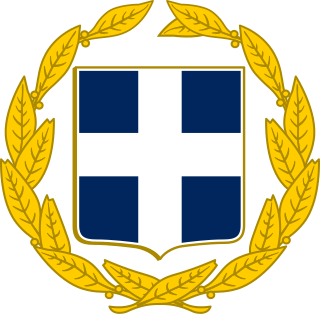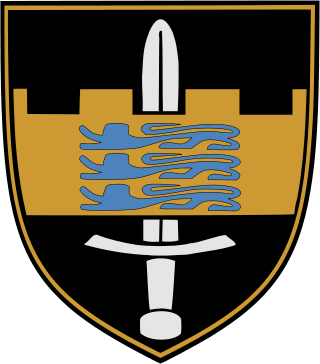
The Hellenic Armed Forces are the military forces of Greece. They consist of the Hellenic Army, the Hellenic Navy, and the Hellenic Air Force.

In military organizations, a colour guard is a detachment of soldiers assigned to the protection of regimental colours and the national flag. This duty is highly prestigious, and the military colour is generally carried by a young officer (ensign), while experienced non-commissioned officers are assigned to the protection of the national flag. These non-commissioned officers, accompanied in several countries by warrant officers, can be ceremonially armed with either sabres or rifles to protect the colour. Colour guards are generally dismounted, but there are also mounted colour guard formations as well.

Combined arms is an approach to warfare that seeks to integrate different combat arms of a military to achieve mutually complementary effects—for example, using infantry and armour in an urban environment in which each supports the other.
Military doctrine is the expression of how military forces contribute to campaigns, major operations, battles, and engagements. A military doctrine outlines what military means should be used, how forces should be structured, where forces should be deployed, and the modes of cooperation between types of forces. "Joint doctrine" refers to the doctrines shared and aligned by multinational forces or joint service operations.
A division is a large military unit or formation, usually consisting of between 10,000 and 25,000 soldiers. In most armies, a division is composed of several regiments or brigades; in turn, several divisions typically make up a corps.
Military ranks are a system of hierarchical relationships within armed forces, police, intelligence agencies and other institutions organized along military lines. Responsibility for personnel, equipment and missions grow with each advancement. Ranks should not be confused with paygrades, such as E-1, W-2 and O-5. Paygrades are administrative classifications used primarily to standardize compensation across the armed services. The military rank system defines dominance, authority and responsibility within a military hierarchy. It incorporates the principles of exercising power and authority into the military chain of command—the succession of commanders superior to subordinates through which command is exercised. The military chain of command is an important component for organized collective action.

A brigade is a major tactical military formation that typically comprises three to six battalions plus supporting elements. It is roughly equivalent to an enlarged or reinforced regiment. Two or more brigades may constitute a division.
Corps is a term used for several different kinds of organization. A military innovation by Napoleon I, the formation was first named as such in 1805. The size of a corps varies greatly, but two to five divisions and anywhere from 40,000 to 80,000 are the numbers stated by the US Department of Defense.

A flight is a small military unit within the larger structure of an air force, naval air service, or army air corps; and is usually subordinate to a larger squadron. A military aircraft flight is typically composed of four aircraft, though two to six aircraft may also form an aircraft flight; along with their aircrews and ground staff. In some very specific examples, typically involving historic aircraft, a flight may contain as many as twelve aircraft, as is the case with the Battle of Britain Memorial Flight (BBMF) of the British Royal Air Force (RAF). In most usages, two or more flights make up a squadron. Foreign languages equivalents include escadrille (French), escuadrilla (Spanish), esquadrilha (Portuguese), patrulă (Romanian), zveno (Russian), and Schwarm (German).

The German Army is the land component of the armed forces of Germany. The present-day German Army was founded in 1955 as part of the newly formed West German Bundeswehr together with the Marine and the Luftwaffe. As of January 2022, the German Army had a strength of 62,766 soldiers.
An army group is a military organization consisting of several field armies, which is self-sufficient for indefinite periods. It is usually responsible for a particular geographic area. An army group is the largest field organization handled by a single commander – usually a full general or field marshal – and it generally includes between 400,000 and 1,000,000 soldiers.
In military aviation, a wing is a unit of command. In most military aviation services, a wing is a relatively large formation of planes. In Commonwealth countries a wing usually comprises three squadrons, with several wings forming a group. Each squadron will contain around 20 planes.
A group is a military unit or a military formation that is most often associated with military aviation.
Deep operation, also known as Soviet deep battle, was a military theory developed by the Soviet Union for its armed forces during the 1920s and 1930s. It was a tenet that emphasized destroying, suppressing or disorganizing enemy forces not only at the line of contact but also throughout the depth of the battlefield.

Military organization (AE) or military organisation (BE) is the structuring of the armed forces of a state so as to offer such military capability as a national defense policy may require. Formal military organization tends to use hierarchical forms.

The Ukrainian Ground Forces, also referred to as the Ukrainian army, are the land forces of Ukraine and one of the eight branches of the Armed Forces of Ukraine. They were formed from Ukrainian units of the Soviet Army after Ukrainian independence, and trace their ancestry to the 1917–22 army of the Ukrainian People's Republic.
The Soviet Ground Forces, successor to the Red Army, the title changing in 1945, employed a wide range of different military formations.

The Soviet Airborne Forces or VDV was a separate troops branch of the Soviet Armed Forces. First formed before the Second World War, the force undertook two significant airborne operations and a number of smaller jumps during the war and for many years after 1945 was the largest airborne force in the world. The force was split after the dissolution of the Soviet Union, with the core becoming the Russian Airborne Forces, losing divisions to Belarus and Ukraine.

The Estonian Land Forces, unofficially referred to as the Estonian Army, is the name of the unified ground forces among the Estonian Defense Forces where it has an offensive military formation role. The Estonian Land Forces is currently the largest Estonian military branch, with an average size of approximately 6,000 soldiers, conscripts, and officers during peacetime.











